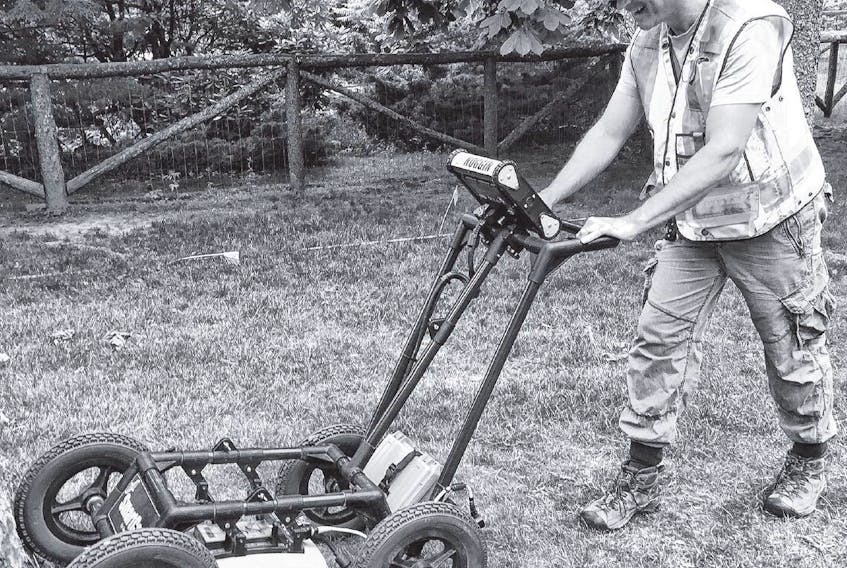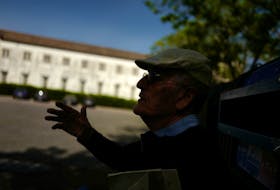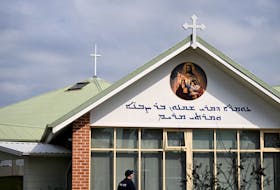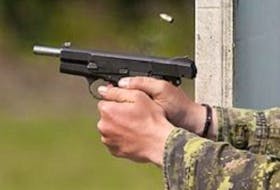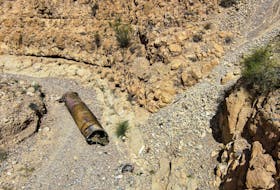An archeological project is seeking the foundations of an historic Victorian-era covered skating rink that once stood in the Halifax Public Gardens.
Jonathan Fowler, a professor at Saint Mary’s University’s anthropology department, is using geophysical technology to create a kind of three-dimensional map of the subsurface of the soil in a localized area he suspects is the site of the rink.
Fowler was using a groundpenetrating radar device on Friday.
He marked out a rectangular area and set marker flags at regular intervals along the boundary lines. He then began the process of slowly guiding the GPR device back and forth across it, using the marks its four wheels left in the grass as a grid guide.
The instrument sends radio waves into the ground. As the waves encounter and pass through different materials, a portion reflects back and is recorded.
The data is logged and later compiled into software for further analysis and an image created.
This unit is looking to a depth of about two metres underground.
The machine is owned by Boreas Heritage Consulting Inc. and Fowler’s own Northeast Archaeological Research Inc. The consulting firms allow Saint Mary’s University to use the hardware and the university owns software licences to teach students how to use the technology.
“It’s been integrated in course work and the university hasn’t had to buy it,” he said.
Fowler said the site data will be complicated to sort through as the rink was demolished to make way for a new gate, which itself is no longer there.
“We’re looking for foundations, primarily,” Fowler said. He expects there will be a debris field of brick and other material.
“And the question is: Can we discern, from that mass of debris, the linear structures that would be the evidence of buried foundations?”
He’s quite confident that he’s on the right spot.
“We’re hoping to make some kind of public presentation of the results in the fall or into the winter and that will . . . depend to some extent on how the data processing goes. It may take us a little bit of time.”
His team will also have to do some other spot surveys to try to fill in the grid due to the on-site trees and other vegetation.
“We’re not going to hoard the data, we’re going to be sharing it with everyone once we decide we understand what’s going on.”
It will be up to the city to decide whether there will be a need to physically dig.
“Personally, I’m always happy to dig holes,” he said jokingly. “(But) any time you do archeology, it’s got to serve either a research program or a heritage resource management strategy. We shouldn’t just dig as a recreational activity because these sites are heritage resources. They’re finite. And every time we dig, we alter them.”
Heidi Boutilier, horticulture supervisor (west) with Halifax Regional Municipality, looks after the Public Gardens with her team.
“For us, for HRM and for the Public Gardens, it’s really (about) that layer of history and bringing it out and sharing it with the public,” Boutilier said.
“There’s a lot of people out there, I’m sure, that will be really interested in the history.”
Janet and Jock Murray created the bursary program that is supporting the Public Gardens work in memory of their daughter Suellen, a Halifax lawyer who worked with the Department of Health.
She died four years ago of a brain tumour.
The Suellen Murray Educational Bursary provides $1,000 to appropriate projects.
“She always walked through here on her way to work,” said Janet, who counts work with the Chronicle Herald, Saint Mary’s and the CBC among her life’s experience.
“So we talked with the board of the Friends of the Public Gardens and we thought that perhaps this kind of bursary . . . would help us to learn more about the Gardens but also help the people who would perhaps win the bursary to further their work a little bit more.”
The rink search is the third project to receive funding from the bursary.
“We thought this was an amazing possibility for a project because many of us — including me — had never heard that there was actually a rink within the Gardens. But there are photographs, so we knew it existed.”
Her husband Jock, a retired neurologist and former dean of medicine at Dalhousie University, finds it interesting that Fowler doesn’t have to dig up anything for his research.
“He has this new technology that allows him to assess what’s under the surface by using a noninvasive kind of technique. And he’s got a number of techniques that will outline a lot of what we don’t know about its size and where it was. So, I think that’s really what was intriguing.”
It also links with so much of the other history of the city and Canada in general, he said.
“And that’s the idea of the bursary, that it will do that kind of thing,” he said. “It will allow someone who has an interesting project — which could be almost anything — but it relates to the background of the Gardens and fostering what the Gardens is really about.”
Judith Cabrita, chairwoman of The Friends of the Public Gardens, said Suellen Murray was fascinated by a blue heron that sometimes visits the gardens.
“The blue heron hadn’t been in the gardens for quite a while and the day that we did the announcement of the Suellen bursary, the heron was in the pond. So that was quite poignant,” Cabrita said. “And so the logo of the bursary is a blue heron.”
For Cabrita and her organization, the project is enormously important.
“It was the first covered skating rink in . . . British North America. They played hockey here and so perhaps we could rival Windsor here with the first hockey game. But it was a very important part of the citizenry, the life in Halifax, in the fact that they had this beautiful indoor rink.”
They want to rediscover the location to further share the importance of the site.
“There wasn’t much of a garden at that time,” Cabrita said. “The horticulture society had a garden further up and the city had a garden down here and they eventually merged and they became the Halifax Public Gardens. It’s historically very, very important.”
For his part, Fowler is honoured to receive the educational bursary and the efforts of the Murrays.
“They’re really enthused, I think, about the notion that we might be able to use this littleknown part of the city’s history and the garden’s history to educate people, tell stories about the Victorian period, give people another way of thinking about the gardens and also show some of the newer technologies that archeologists are using, as well,” he said.
After making a couple of passes with the GPR unit, Fowler found the preliminary data display fascinating. It looked like there were some interesting signals returned to the data logger.
“So when we get into the software, I’ll be tuning that up,” he said. “This is fainter but it could be a really big deal.”
We’ll have to wait til the fall to know the answer.

